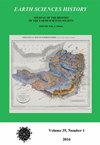“世界上最伟大的矿产产地”:哈伊奥姆、恩东加、赫雷罗和津巴布韦的早期殖民历史
IF 0.6
4区 哲学
Q4 GEOSCIENCES, MULTIDISCIPLINARY
引用次数: 0
摘要
纳米比亚奥塔维山脉的Tsumeb铜矿以其壮观的矿物标本和无与伦比的矿物物种多样性而闻名。该遗址开采了近100年,最初由英德集团开采,后来由跨国公司开采;然而,在此之前,该遗址是Ndonga、Haiǁom和Herero的经济中心,他们开采、冶炼、制造和交易铜。本文试图填补Tsumeb早期历史上的一个重大空白:Tsumeb的铜控制权是如何从当地社区转移到德国的?通过综合各种来源,本文告诉了Tsumeb地区铜的殖民前和殖民早期历史,重点介绍了开采铜的Haiǁom、冶炼和制作铜的Ndonga以及与土地有历史关系的Herero。在整个过程中,本文试图将Tsumeb的当地历史与西南非洲(现在的纳米比亚)的更大区域背景联系起来,并更深入地描述在Tsumeb以前的矿物学史中,这些社区的角色被简化为:“当地人的麻烦”本文章由计算机程序翻译,如有差异,请以英文原文为准。
THE “WORLD’S GREATEST MINERAL LOCALITY”: HAIǁOM, NDONGA, HERERO, AND THE EARLY COLONIAL HISTORIES OF TSUMEB, NAMIBIA
The Tsumeb copper mine in the Otavi Mountains of Namibia is famous both for its spectacular mineral specimens and for its unparalleled diversity of mineral species. The site was mined for nearly 100 years, first by Anglo-German and then by multinational companies; however, prior to that, the site was central to the economies of the Ndonga, Haiǁom, and Herero, who mined, smelted, crafted, and traded the copper. This paper attempts to fill a major gap in the early history of Tsumeb: how did control of Tsumeb’s copper transfer from local communities to Germany? By synthesizing a wide variety of sources, this paper tells pre-colonial and early colonial histories of copper in the Tsumeb area, focusing on the Haiǁom who mined the copper, the Ndonga who smelted and crafted it, and the Herero who had historical relationships with the land. Throughout, the paper attempts to connect Tsumeb’s local history with the larger regional context of South West Africa (now Namibia), and to provide a more in-depth account of the communities whose roles, in previous mineralogic histories of Tsumeb, have been reduced to: ‘trouble with the natives.’
求助全文
通过发布文献求助,成功后即可免费获取论文全文。
去求助
来源期刊

Earth Sciences History
GEOSCIENCES, MULTIDISCIPLINARY-HISTORY & PHILOSOPHY OF SCIENCE
CiteScore
1.00
自引率
0.00%
发文量
1
审稿时长
>12 weeks
期刊介绍:
Earth Sciences History promotes and publishes historical work on all areas of the earth sciences – including geology, geography, geophysics, oceanography, paleontology, meteorology, and climatology.
The journal honors and encourages a variety of approaches to historical study: biography, history of ideas, social history, and histories of institutions, organizations, and techniques.
Articles are peer reviewed.
 求助内容:
求助内容: 应助结果提醒方式:
应助结果提醒方式:


